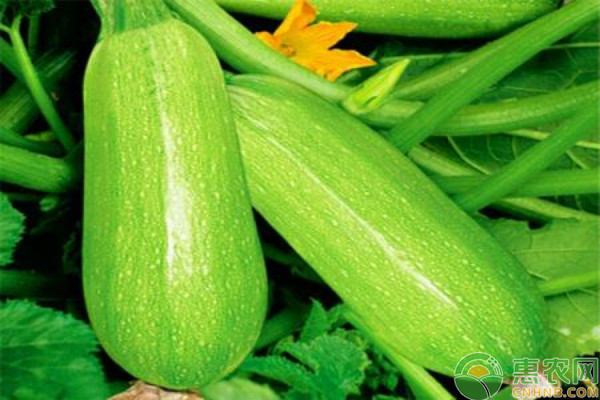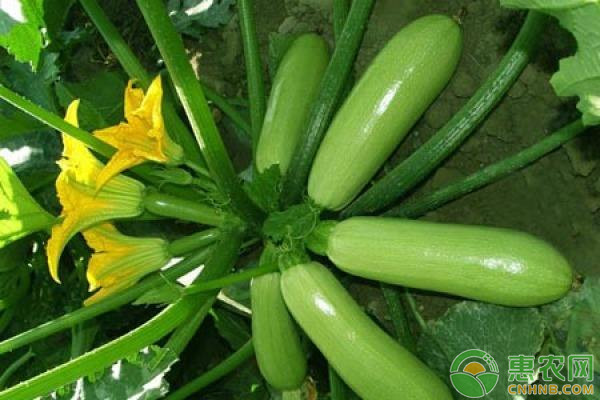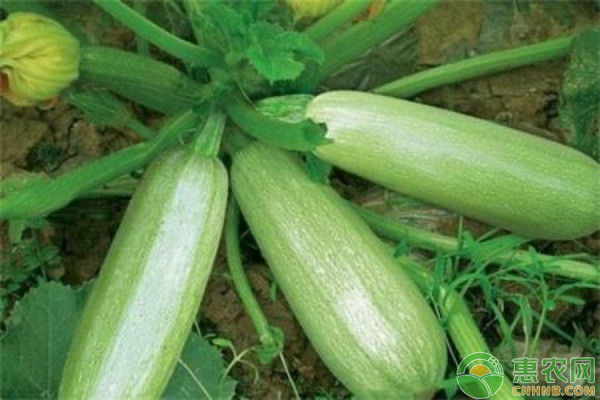What are the common pests and diseases in the cultivation of zucchini? How to prevent it? Let's talk to you about the occurrence and prevention measures of the main diseases of zucchini. The farmers who need it will come to Huinong.com!

First, zucchini virus disease
Viral disease is the main disease of zucchini. It is widely distributed and occurs everywhere. It can be damaged in protected areas and open fields. The general incidence rate is 10%~15%. In severe cases, the diseased plants reach 80% or more, and the yield is often reduced by 3~4%. Its fruit quality is inferior. This disease can also harm cucumbers, melons, sweets and other melons. Symptoms: The disease can occur from seedling to adult stage.
Pathogenesis: Toxic can overwinter on the protection of sweet potatoes, solanaceous fruits and other vegetables and weeds. In the following year, it can spread through locusts, and it can also be transmitted through agricultural operations. The seeds themselves can also be poisoned. High temperature and drought are conducive to the occurrence of viral diseases. The disease is seriously affected by the long-term management of small zucchini, lack of water and fertilizer, strong light, and a large number of aphids.
Control measures: Select disease-resistant varieties, and choose short-term early-maturing varieties and mosaic-type varieties. Seed disinfection, soaking with 10% trisodium phosphate for 20 minutes before sowing, then washing and germination. It can also be soaked in warm water at 55 ° C for 40 minutes, or dried at 70 ° C for 3 days. Apply enough base fertilizer, timely topdressing, less watering in the early stage, more cultivating, and promote root growth and development. Timely control of aphids, early diseased seedlings should be removed as early as possible, pay attention to timely watering and fertilization in the middle and late stages, and strengthen field management. 20% virus A wettable powder 500 times solution, 1.5% phytopathogenic emulsion 1000 times solution, or NS-83 antagonist 100 times solution, or anti-toxic agent No. 1 water agent 250 times solution can be used in the early stage to the initial stage. Face, once every 10 days, spray 2 to 3 times in a row.

Second, zucchini gray mold
Botrytis is a very important disease, widely distributed, and is common in protected areas in the north. Once the onset of the disease is heavier. The rate of melons is 8% to 25%, and when it is severe, it is more than 40%.
Symptoms: This disease mainly harms melons and also harms flowers, young melons, leaves and vines. The germs initially invade from the defeated flowers, causing the flowers to rot, producing a gray mold layer, and then developing from the diseased flowers to the young melons. At the beginning of the diseased melon strip, the top is chlorotic, and then the water stain is soft rot and atrophy, and a gray mold layer is formed thereon. Diseased flowers or diseased melons come into contact with healthy stems, flowers and young melons that cause disease and rot.
Sometimes dark brown small granular sclerotia grows on the diseased melon.
Pathogenesis: The bacteria overwinter in the soil and on the diseased bodies with sclerotia, conidia or hyphae. Conidia are spread by airflow, watering or farming operations. The suitable temperature for growth of pathogens is 18~24°C, the onset temperature is 4~32°C, the optimum temperature is 22~25°C, and the air temperature is above 90%. The plant expression condensation is easy to induce this disease.
Control measures: 1 thoroughly remove the sick leaves and debris after pulling the sputum, use 20% keeling smoke agent or 20% gram smoked agent 15 kg / ha smoked shed for 12~24 hours, or use 65 % of the methicillin WP 400 times solution, or 50% carbendazim WP 500 times solution, or 40% levy suspension 600 times solution, or 45% Tec lot suspension 800 times solution, or 50% enemy Bactericidal wettable powder 400 times solution, or 50% speed Keling wettable powder 600 times liquid carefully sprayed on the ground, walls, shed film, etc., for performance sterilization. 2 The use of high mulch film covering and scaffolding cultivation, combined with drip irrigation, tube irrigation and other water-saving measures can effectively control the disease. 3 Strengthen management, avoid watering in rainy days, and pay attention to increase ventilation after watering and reduce air humidity. Timely remove the lower defeated flowers and old yellow feet, and find that the diseased melons are carefully placed in plastic bags and taken to the outside of the shed for proper disposal. 4 In the early stage of the disease, use 50% Nongli Ling WP 1000 times solution, or 65% Methylaloxone WP 500 times solution, or 40% application of Le Suspending Agent 800~1000 times solution, or 50% carbendazim wettability. Powder 500 times solution, or 45% Tec lot suspension 800 times liquid spray, focusing on spraying flowers and young melons. The protective ground is used to control the dust of gray mold, such as 6.5% of the moldy powder of dust of 15 kg/ha, or the spray of 20% of the gram of aerosol of 4.5~7.5 kg/ha.
Third, zucchini cotton rot
Mian rot disease is an important disease of the open field zucchini, which occurs frequently and the protected area is sporadic. Low-lying areas or rainy years have a greater impact on production, resulting in a large number of rotten melons, with an estimated loss of 10% to 30%.
Symptoms: This disease is mainly harmful to fruits and fruits, and sometimes also to leaves and stems and other parts. The fruit of the melon fruit is a water-stained oval dark green spot at the beginning, or it is stained with water stains from the flower that is defeated. After the onset, the diseased part is soft and brown, and the surface produces dense flocculent white mold. The whole melon strip is rotten. The air is dry, the lesions are sunken, and the disease develops slowly. Only the flesh of the diseased part is brown and rot, and a small amount of white mold is produced on the surface. The leaves are infected, and the leaves are nearly round to amorphous dark green water-stained spots. When the humidity is high, the leaves are hot and rotten. The air is dry and the lesions are dry and detached.
Incidence pattern: The bacteria overwinter in the soil with oospores. Conditions suitable for sporangia and zoospores infect the host, or directly grow the germ tube into the host. The diseased part produces sporangia and zoospores, which are spread by rain or watering for reinfection. Lower temperature or high temperature can cause disease. The severity of the disease and the speed of the disease depend on humidity and rainfall. It is hot and rainy, especially in the field, where the soil is wet and the disease is serious.
Control method: cultivating with high sorghum or high ridge mulch and scaffolding. Reasonable watering, avoid flooding of large water, timely drainage after rain, appropriate application of potassium fertilizer, and timely removal of diseased melons. The severely ill area was uniformly applied to the planting ditch with 45-75 kg/ha of copper sulphate before planting, or diluted with water and poured into the soil.
In the early stage of the disease, the drug control can be carried out: 72% cream urea·manganese zinc wettable powder 800 times liquid, or 50% lysozyme wettable powder 800 times liquid, or 72.2% Plex water 800 times liquid, or 69% Anke · Mn-Zn wettable powder 1000 times solution, or 80% Safford WP 400 times liquid spray.

4. S. cerevisiae rot disease
Rhizopus rot is the main disease of zucchini, which is widely distributed and occurs frequently. Both protected areas and open fields occur. The melon rate is generally 10% to 30%, and the diseased or shed disease can reach more than 40%, affecting production.
Symptoms: This disease mainly harms young melons and also harms flowers and petioles. Most of the pathogens infect the infected flower or the injured tissue, causing the diseased part to be necrotic and rotted, forming a burr-like black to gray-black hairy mold layer on the surface of the decayed tissue. The melon strips are mostly infected by flower organs, and the rapid development of the melon strips along the umbilicus leads to the soft rot of the whole melon. The surface of the diseased melon grows thicker burr-like black to gray-black hairy mold layer, and the rotten melon often has a foul smell.
Pathogenesis: The pathogen is a weak parasitic bacteria, which is extremely rot, and the natural distribution in the field is very common. It can survive in the mycelial state on a variety of vegetable residues. Cyst spores are attached to the surface of the field and all exposed surfaces in the protected area for wintering.
When the conditions are appropriate, the pathogen is invaded by a wound or a weakened part with low vitality. After invading the pathogen, a pectinase is secreted to rapidly decompose the intercellular substance, causing decay, and a large number of spores are spread and spread with airflow, rainwater or watering, forming multiple repeated infections. Warm and humid is conducive to the onset of disease, the suitable temperature for growth of the bacteria is 23~28 °C, and the relative humidity is required to be more than 80%. The field is watered, the soil and air are humid, and the disease is heavier.
Flat land planting, no mulch cultivation, and management of extensive plots are seriously affected.
Control method: 1 Thoroughly remove all residual tissue from the previous crop before planting. If necessary, the surface of the surface and the walls, columns, and shelves of the protective ground may be sprayed with a slightly thicker liquid than the long-term spray control. 2 Adopt high ridge or sorghum mulching to cover cultivation. 3 Careful management, timely removal of diseased melons, sick flowers and decaying residual flowers. Avoid causing various wounds and reduce the chance of infection. 4 After the rain or after watering, avoid the accumulation of water in the field, strengthen the ventilation and dehumidification, and inhibit the occurrence and development of diseases. Immediately after the onset of drug control, 50% carbendazim wettable powder, or 50% polysulfurate suspension 500 times solution, or 70% methyl thiophanate WP 800 times solution, or 50% chlorhexidine wettability Powder 1500 times solution, or 80% Dasheng wettable powder 800 times liquid spray.
The above is the whole content of the occurrence and prevention measures of the main diseases of zucchini, and the farmers who have planted zucchini and do not know how to prevent pests and diseases come to see it!
Automatic Nucleic Acid Extractor
Nucleic acid extraction instrument is an instrument that automatically completes the nucleic acid extraction of samples by applying the supporting nucleic acid extraction reagents. Widely used in disease control centers, clinical disease diagnosis, blood transfusion safety, forensic identification, environmental microbial testing, food safety testing, animal husbandry and molecular biology research and other fields.
Using magnetic beads as the carrier, using the principle that magnetic beads adsorb nucleic acid under high salt and low pH value, and separate from nucleic acid under low salt and high pH value, and then move the magnetic beads or transfer the liquid to realize the entire extraction and purification process of nucleic acid. Due to the uniqueness of its principle, it can be designed into a variety of throughputs, which can be extracted from a single tube or 8-96 samples, and its operation is simple and fast. It only takes 30-45 minutes to extract 96 samples, which greatly improves the The experimental efficiency is low and the cost is low, so it can be used in different laboratories, and it is the mainstream instrument on the market.
Features of Magnetic Bead Nucleic Acid Extractor
1. Enables automated, high-throughput operations.
2. Simple and fast operation.
3. Safety and environmental protection.
4. High purity and high yield.
5. No pollution and stable results.
6. Low cost and easy to be widely used.
7. Different types of samples can be processed simultaneously.
Nucleic Acid Extraction System,Automatic Nucleic Acid Extractor,Nucleic Acid Extraction Machine,Nucleic Acid Extraction Instrument
Jilin Sinoscience Technology Co. LTD , https://www.contoryinstruments.com